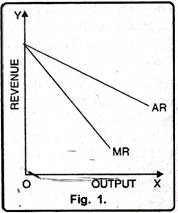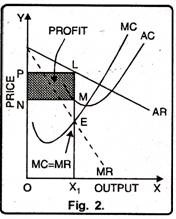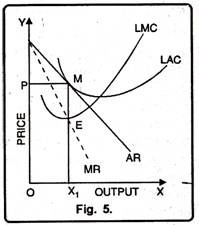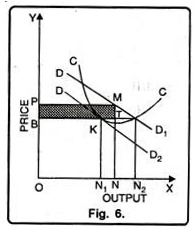The concept of monopolistic competition was put-forth by an American economist Prof. E.H. Chamberlin in his popular book, “The Theory of Monopolistic Competition” published in 1933.
In simple words, monopolistic competition refers to a market situation where there are many sellers of a commodity, but the product of each seller differs from each other.
No seller can have any perceptible influence on the price output policies of the other seller nor can he be influenced by their action. Thus, product differentiation is the hall mark of the monopolistic competition.
The product differentiation manifests itself in several ways like difference in product brand, difference in trade mark, difference in quality and colour etc. However, many examples can be put forward to explain the concept of monopolistic competition.
ADVERTISEMENTS:
All the firms producing soaps, toothpastes etc. are the examples of monopolistic competition. Under monopolistic competition, a firm enjoys some features of monopoly and perfect competition. For instance, Hindustan Levers Ltd. enjoys monopoly right on the trademark “Lux”. No other firm can use this trade mark. The other firms enjoy their own trade mark like Moti.
Sandal, Breeze etc. so that they may produce the substitute of Lux. In this way, under monopolistic competition features of monopoly and perfect competition are found. Thus, we can say that monopolistic competition is a market situation which lies between monopoly and perfect competition.
Definitions:
“Monopolistic competition is a market situation in which there are many sellers of a particular product, but the product of each seller is in some way differentiated in the minds of consumers from the product of every other seller.” Leftwitch
“Monopolistic competition is a market situation where there are many producers but each offers a slightly differentiated product.” Lim Chong Yah
ADVERTISEMENTS:
“Monopolistic competition is found in the industry where there are a large number of small sellers selling differentiated but close substitute products.” Joe S. Bain
“Monopolistic competition has today come to mean a state of affairs in which there is a large number of sellers selling non-homogeneous or slightly differentiated products and in which freedom of entry exists.” H.H. Liebhafsky
Nature of Demand and Cost:
(i) Demand Curve:
Like perfect competition and monopoly, price under monopolistic competition is also determined by the intersection of demand and supply. Therefore, before studying the price determination under monopolistic competition we must have knowledge of demand and supply curves of a firm. Generally under monopolistic competition due to product differentiation, a firm faces a downward sloping demand curve. It is highly elastic but not perfectly elastic within a relevant range of prices at w which he can sell any amount of the product.
The reason is that if a producer raises the price of the product, some of his customers will stop buying his product and will shift to his rival firm who has not changed his price. On the other hand, if he lowers his price, he will attract some new customers. The shape of the demand curve is shown in Fig. 1.
(ii) Cost Curve:
Under monopolistic competition Average Cost (AC), Average Variable Cost (AVC), Marginal Cost (MC) is also of U-shape. We know, selling cost is the special feature of imperfect competition. Basically, selling costs are incurred on advertising of product. According to Chamberlin, selling cost curve is also y-shaped. The supply curve under monopolistic competition of the industry cannot be drawn due to product differentiation.
Equilibrium Price and Output under Monopolistic Competition:
Short Run Equilibrium:
According to Prof. Chamberlin, the firm under monopolistic competition has to make a wider range of decisions than under perfect competition. The firm may vary its price and with it, its sales and output; it may vary the quality of its product and it may engage in sales-promotion activities such as advertisement, publicity and propaganda, etc.
Thus, there are three variables under monopolistic competition, viz.;
(i) Price,
(ii) Product; and
(iii) Selling outlay.
It would be very difficult to discuss their effects simultaneously. Therefore, the equilibrium of individual firm is discussed here with reference to prices and output adjustments, assuming that the selling costs are absent. In other words, now we shall examine the individual equilibrium and then examine group equilibrium.
Individual Equilibrium:
It should be recalled here that for maximum profits two conditions are to be satisfied under perfect competition and monopoly; (1) MC = MR and (2) MC must cut MR from below. Under monopolistic competition also, a firm will make the maximum profits when these two conditions are satisfied.
However, in short period, it is not necessary that all the firms should have iso-classic demand curves. The elasticity of demand curve under monopolistic competition depends upon the attachment of the buyers. So, this it will depend upon the age of the firm (and of the product).
ADVERTISEMENTS:
If a firm is an old one, it shall be selling its product for a long time and consequently the buyers will have a less elastic or inelastic demand for its products. On the contrary, a comparatively, new firm will have a more elastic demand curve for its product.
Thus, older firms will have greater price advantage while newer firms will have lesser price advantage. Since it is assumed that product differentiation or the effects of selling costs are absent, cost curves of different firms will be identical.
It follows therefore that older firms will make abnormal profits while newer firms may have normal profits or even losses. To be very clear and simple, it is stated that there may be three equilibrium conditions of a firm in the short period under monopolistic competition, viz.
(1) It may earn abnormal profits;
ADVERTISEMENTS:
(2) It may undergo losses;
(3) It may earn only normal profits.
(4) Super Normal Profit
Under monopolistic competition, a firm earns maximum profits or is in equilibrium when MC=MR and MC cuts MR from below. In the fig. 2. the firm is in equilibrium at OX] level of output and at the point E, at which MR and MC are equal and MC cuts MR from below.
ADVERTISEMENTS:
The firm is earning super-normal profits or abnormal profits since average revenue is greater than average cost, i.e., AR > AC. The main reason for these abnormal profits is that, the other rival firms are not able to produce closely competitive substitutes. Hence, they are not able to attract consumers towards their product.
2. Normal Profit:
If under monopolistic competition, the price of product is equal to AC, the firm will be earning normal profit. In Fig. 3 MC is equal to MR at point E. This is the equilibrium point. At equilibrium point, the equilibrium output is OX1 and price is OP1. At this point, AC is NX1 and AR is also NX1 i.e., AC=AR. Thus the firm will be earning only normal profits.
3. Sustaining Losses:
ADVERTISEMENTS:
However, it is also possible that the demand may not be favourable to firm under monopolistic competition, i.e., it may not be able to attract the consumers towards its product, if it fixes price equal to its SAC. But it is compelled to sell its product at the price which is less than even its short period average cost.
Hence, it may incur losses such firm, in the long-run may leave the industry, if it is not possible for it to change its demand relative to its cost conditions through product differentiation and advertisement. In figure 4 the firm is in equilibrium at point E, where MC=MR. At this equilibrium level the output is OX1 at price OP. Corresponding to this, the average cost LX1 is greater than average revenue MX1, Since, revenue is less than cost, the firm will sustain losses equal to the shaded area PLMN.
Long Run Individual Equilibrium:
Long period refers to that time period in which each firm can change its production capacity by changing the fixed as well as variable factors. New firms can enter the industry and old firms can exit it. Basically, the firms in the long run will get the normal profits.
If, the existing firms are making super normal profits, it will attract some of the new firms in the industry. The entry of new firms will result into over production which will have a depressing effect on price. Hence all the firms in the long run will get normal profits. In fig. 5 output is measured on X-axis whereas price on Y-axis. LAC is the long run average cost and LMC is the long fun marginal cost curve. The firm is in equilibrium because at point E, MC = MR. The equilibrium output is OX1 and price is OP. Since, at this equilibrium average revenue curve is tangent to long run average cost curve at point M; hence the firms are earning normal profits.
Group Equilibrium in Monopolistic Competition:
ADVERTISEMENTS:
Under monopolistic competition, the word ‘group’ is used for industry. There is a difference between an industry and a group. An industry generally consists of firms which produce homogeneous product, whereas a group is composed of firms which produce a differentiated product. Thus group consists of a number of firms producing close substitutes. For example, shoe making firms like ‘Bata’, ‘Carona’, and ‘Liberty’ are a group.
To study group equilibrium, we assume that:
(i) Demand and cost curves of all the firms are identical,
(ii) No firm can influence the price and output decisions of its rivals.
The Group Equilibrium is shown below with the help of Fig. 5.
In Fig. 6, DD1 is the group demand curve and CC is the cost curve. Every firm would like to fix up OP price because at this price the difference between price and cost is the maximum and producer gets supernormal profit equal to PMTB. The other firms will be attracted to enter the market and now the market demand will be shared by a larger number of firms. In this situation demand curve will shift downwards and the new demand curve will be DD2.
ADVERTISEMENTS:
The number of firms in the market will continue increasing till the new demand curve DD2 is tangent to the cost curve. In the Fig. 6 at point ‘K’ demand curve is tangent to the cost curve. At this point firm will be earning only normal profit and this will be the equilibrium position of the firm. Thus under monopolistic competition, OB is the equilibrium price and ON] is the equilibrium output.





